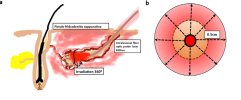Found this:
https://www.drugs.com/pro/metvixia.html
This is one of the pro red lights used with Methylene Blue... It says 37 J/cm2 is appropriate intensity for treatment.
1 Joule is 1 W/s.
So, that would mean we need 37W of red LED light per 1 cm2 of skin. BUT, they also say in the study that typical treatment time is 8 minutes, or 480 seconds.
The link above also says to position the light 5-8cm from skin, which will give a patch of red light 8 x 18cm in size.
Thus, we have 8 x 18 = 144 cm2 (22 in2)
If treatment dose of light is 37 W/s/cm2, that means we would need:
144cm2 x 37 W/s/cm = 5328 W/s (for only 1s)
That's a LOT of LED power! But if the treatment time is 480 seconds, we divide that power to get:
5328 W/s -> 11.1W for 480 seconds of treatment
That's still quite a bit of power for a LED lamp. Typical GU10 50W halogen spot light bulb in LED format is ~5W.
The reason I'm calculating all of this is because I found and ordered a handheld 633nm LED light off Amazon, but they didn't specify power output.
Of course, if you reduce the distance between the light and the skin so that the patch covered in red light is 1/4 the size (about 36cm2 or 5in2), then the power output for 8 minutes of treatment is reduced to 2.775 W, which is far more reasonable for a handheld, battery-powered device. Or, you just increase treatment time with the light.
I'm assuming that LED input power is directly equal to the output power of the red light being generated, which is definitely not the case. But at least it gets us in the general ballpark - instead of just guessing.
Assuming I'm not talking smack here, then it seems an expensive medical-grade light is not required. The only requirement is that the LEDs produce 635nm red light. Even the medical-grade one above has a light wavelength tolerance of +/- 5%, which would be 603 - 666nm. This tells me that they are NOT using "high-precision" LEDs that are specially made... But they are making lots of money!
When our handheld unit arrives, I'm gonna do some calculations.
Note that you can buy 625nm 1.1W LEDs on Conrad.fr, but they're 12€ each. The 630nm variant is 0.20€ each, but they are only 0.04W each, so you'd need 277 of them to equal 11.1W.
Anyway, finally I'd like to note that I once used a simple red-tinted lightbulb along with a blue-tinted one to try to help treat acne on the back of my shoulders, and it seemed to help. And that was just a simple tinted-glass incandescent bulb!
So the results of this experiment will be interesting, esp. with the Methylene Blue and more precise wavelengths of red light.

https://www.drugs.com/pro/metvixia.html
This is one of the pro red lights used with Methylene Blue... It says 37 J/cm2 is appropriate intensity for treatment.
1 Joule is 1 W/s.
So, that would mean we need 37W of red LED light per 1 cm2 of skin. BUT, they also say in the study that typical treatment time is 8 minutes, or 480 seconds.
The link above also says to position the light 5-8cm from skin, which will give a patch of red light 8 x 18cm in size.
Thus, we have 8 x 18 = 144 cm2 (22 in2)
If treatment dose of light is 37 W/s/cm2, that means we would need:
144cm2 x 37 W/s/cm = 5328 W/s (for only 1s)
That's a LOT of LED power! But if the treatment time is 480 seconds, we divide that power to get:
5328 W/s -> 11.1W for 480 seconds of treatment
That's still quite a bit of power for a LED lamp. Typical GU10 50W halogen spot light bulb in LED format is ~5W.
The reason I'm calculating all of this is because I found and ordered a handheld 633nm LED light off Amazon, but they didn't specify power output.
Of course, if you reduce the distance between the light and the skin so that the patch covered in red light is 1/4 the size (about 36cm2 or 5in2), then the power output for 8 minutes of treatment is reduced to 2.775 W, which is far more reasonable for a handheld, battery-powered device. Or, you just increase treatment time with the light.
I'm assuming that LED input power is directly equal to the output power of the red light being generated, which is definitely not the case. But at least it gets us in the general ballpark - instead of just guessing.
Assuming I'm not talking smack here, then it seems an expensive medical-grade light is not required. The only requirement is that the LEDs produce 635nm red light. Even the medical-grade one above has a light wavelength tolerance of +/- 5%, which would be 603 - 666nm. This tells me that they are NOT using "high-precision" LEDs that are specially made... But they are making lots of money!
When our handheld unit arrives, I'm gonna do some calculations.
Note that you can buy 625nm 1.1W LEDs on Conrad.fr, but they're 12€ each. The 630nm variant is 0.20€ each, but they are only 0.04W each, so you'd need 277 of them to equal 11.1W.
Anyway, finally I'd like to note that I once used a simple red-tinted lightbulb along with a blue-tinted one to try to help treat acne on the back of my shoulders, and it seemed to help. And that was just a simple tinted-glass incandescent bulb!
So the results of this experiment will be interesting, esp. with the Methylene Blue and more precise wavelengths of red light.





 I managed to get that paper very easily.
I managed to get that paper very easily.